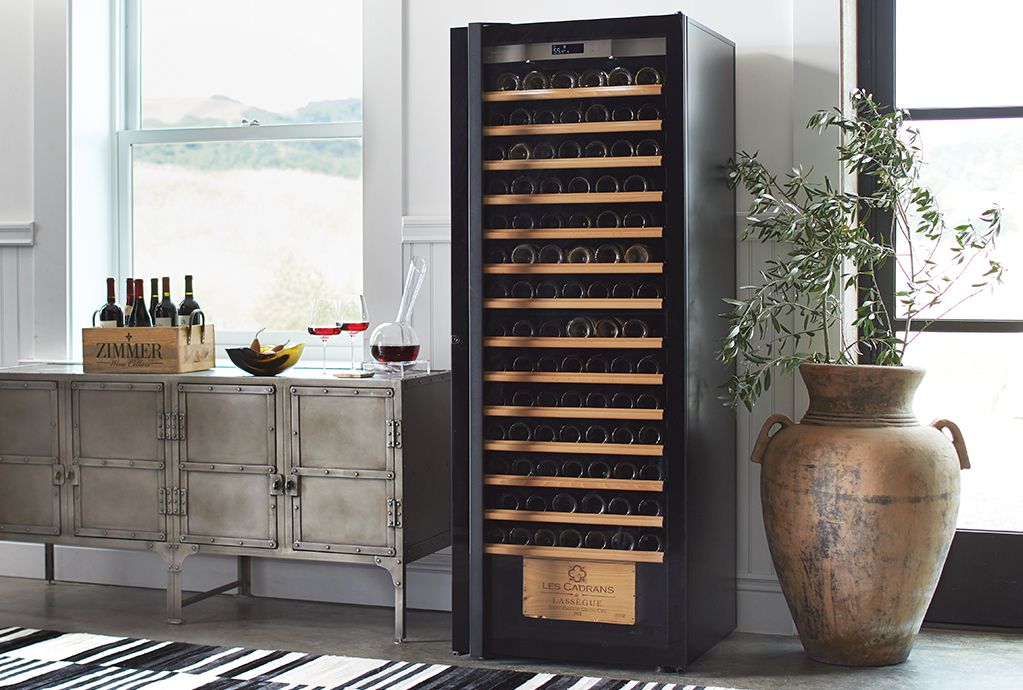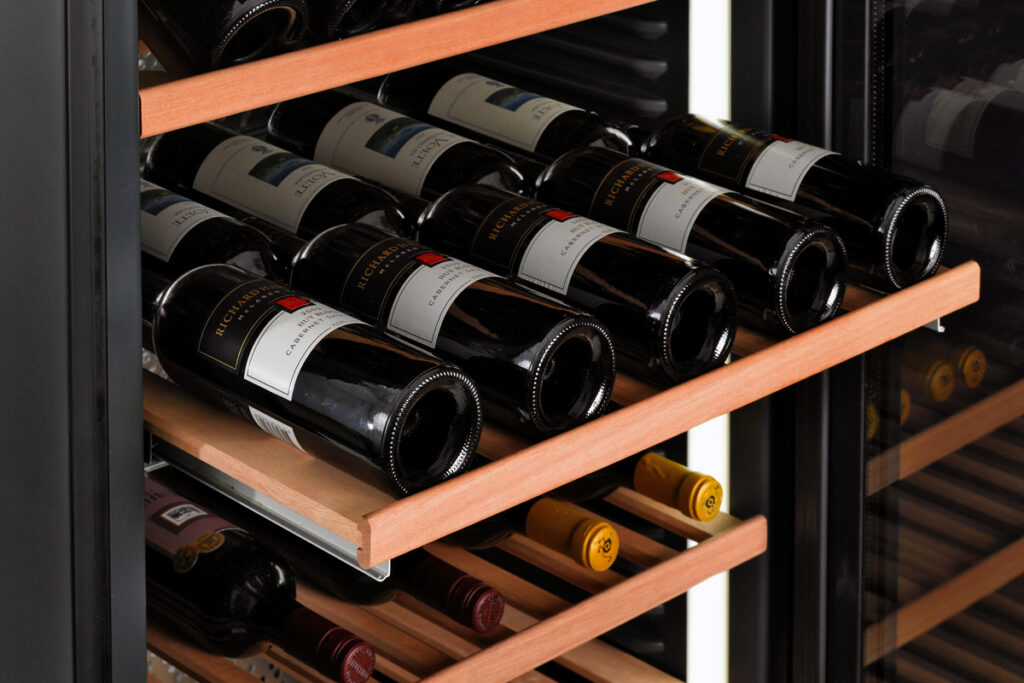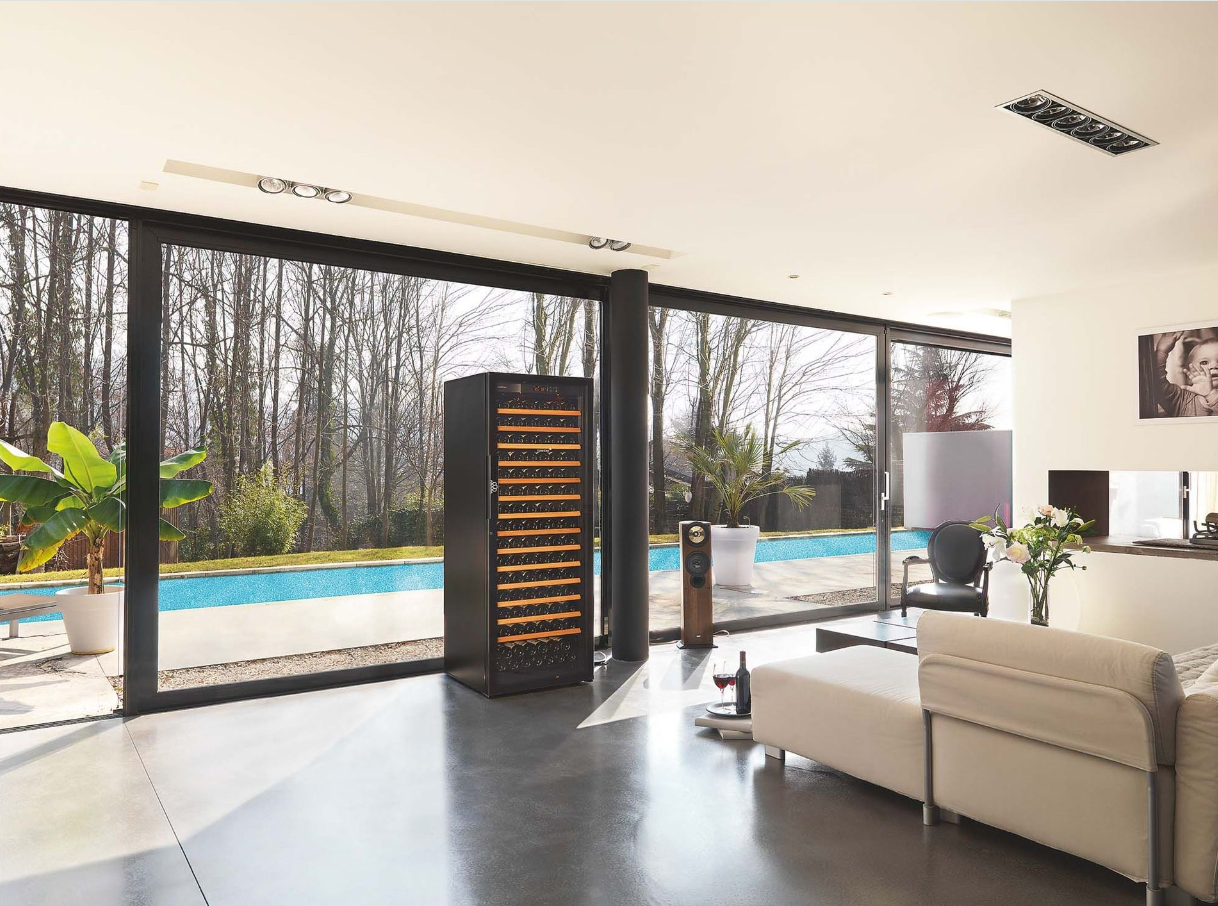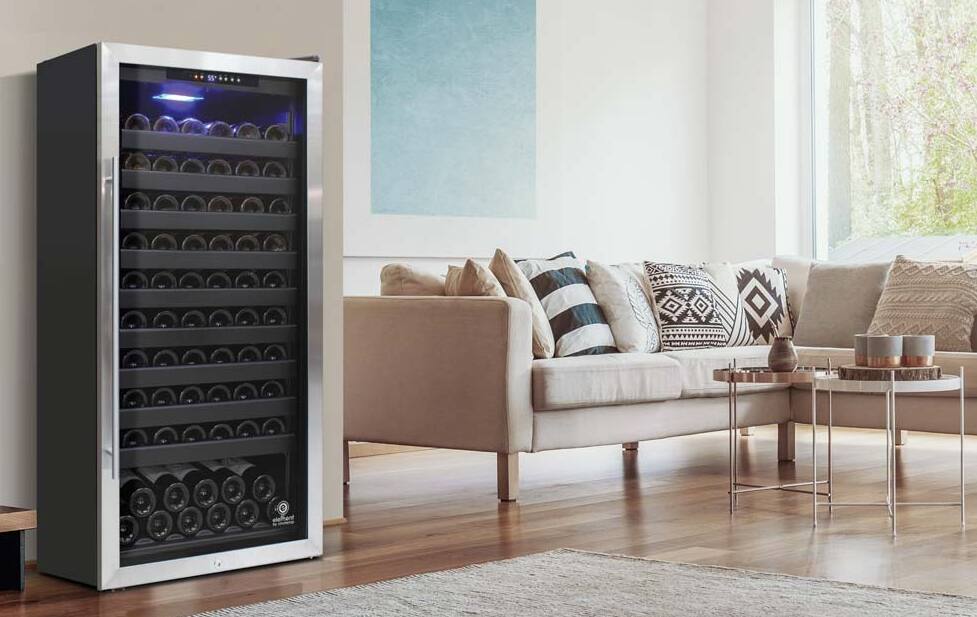Wine Refrigerator Ultimate Buying Guide

Are you a wine enthusiast looking to enhance your collection and keep your favorite vintages in perfect condition, but unsure if wine fridges are worth it? Storing your wine collection properly is essential to preserving the quality of your favorite bottles and one of the best ways to do this is by investing in a wine refrigerator. A wine refrigerator, also known as a wine cooler, is a specialized appliance designed to store wine at the ideal temperature and humidity level. Choosing the right wine refrigerator can be a daunting task, especially if you’re not familiar with the key features and specifications to consider. That’s why we’ve put together the ultimate wine refrigerator buying guide to help you make an informed decision. In this guide, we’ll cover everything from the basics of understanding wine refrigerators to the most important features to look for when buying one to help you make informed choices and choose the best wine refrigerator for your needs!
Understanding wine refrigerators
When it comes to preserving and serving wine, a wine refrigerator is an excellent investment. However, with so many options available, it can be challenging to know which one to choose. In this section, we’ll explore the different types of wine refrigerators, the benefits of owning one, and whether a wine refrigerator is a good investment.
Types of wine refrigerators
Wine refrigerators, also known as wine coolers or wine fridges, come in various types and styles to cater to different preferences and storage needs. Here are some common types of wine refrigerators:
- Single Zone Wine Refrigerators: These units have one temperature zone, making them suitable for storing one type of wine at a consistent temperature. Uncover best buy single zone wine fridge in our article about the differences between single and dual zone wine refrigerators.
- Dual Zone Wine Refrigerators: Dual zone wine refrigerators have two separate temperature zones, allowing you to store different types of wine (such as red and white) at their ideal serving temperatures. Discover the top-rated dual zone wine fridges in our guide outlining the distinctions between single and dual zone wine refrigerators.
- Built-in Wine Refrigerators: Designed to be built into cabinetry or under countertops, these wine refrigerators provide a seamless and integrated look in kitchens or bars. Dive into our curated list of top-tier buil-in wine fridges in our dedicated article.
- Freestanding Wine Refrigerators: These units can stand independently, allowing flexibility in placement within a room. They don’t require built-in installation. Explore our comprehensive article on the best freestanding wine refrigerators to find top-rated options in this category.
- Countertop Wine Refrigerators: Compact units designed to sit on countertops or other flat surfaces, making them suitable for smaller spaces or for those who don’t have floor space for larger models. Uncover the highest-rated countertop wine cooler in our featured article.
- Under Counter Wine Refrigerators: These compact devices are designed to chill a single bottle of wine quickly. They are often used for serving wine at the right temperature rather than long-term storage. Read our article showcasing the top-ranked under counter wine fridges for your consideration.
- Compressor Wine Refrigerators: These units use a compressor-based cooling system, similar to traditional refrigerators, providing efficient and powerful cooling. Unearth the most highly recommended compressor wine fridges with insights from our detailed article.
- Thermoelectric Wine Refrigerators: Utilizing a thermoelectric cooling system, these wine refrigerators are known for being quieter and having fewer moving parts. They are often preferred for smaller collections. Consult our article for an in-depth analysis of the best thermoelectric wine fridges on the market.
- Vertical Wine Refrigerators: Some wine refrigerators are designed with vertical storage, allowing bottles to be stored upright. This can be useful for those with limited horizontal space.
- Large-Capacity Wine Cellars: For serious wine collectors, large-capacity wine cellars provide extensive storage space and often come with advanced temperature and humidity controls. Check out our expert recommendations for the finest large wine fridge in the market.
- Smart Wine Refrigerators: These units are equipped with smart technology, allowing users to control and monitor the temperature and conditions remotely through a mobile app.
- Wine Cabinets: A wine cabinet is a specialized furniture designed for storing and showcasing wine bottles. It ensures optimal conditions for aging and preservation by incorporating features like temperature and humidity control, UV protection, and ventilation. Wine cabinets come in various sizes and styles, catering to different preferences and purposes, from short-term storage to long-term aging. Examine our in-depth guide to discover the differences between wine cabinets and wine coolers.
Benefits of a wine refrigerator
A wine refrigerator provides several benefits that make it a worthwhile investment for wine enthusiasts. First, it helps to preserve the quality of the wine by keeping it at the optimal temperature and humidity level. This ensures that the wine ages correctly and doesn’t spoil or lose its flavor. Additionally, a wine refrigerator provides a convenient and organized way to store and display your wine collection.
Vibrations can negatively impact the aging process of wine. Wine refrigerators are designed to minimize vibrations, which can disturb sediments in the bottle and affect the wine’s flavor.
Exposure to light, especially UV rays, can be harmful to wine. Wine refrigerators are typically designed with UV-resistant glass or solid doors to shield the bottles from light and maintain the wine’s quality.
Wine refrigerators come in various sizes, from small countertop units to larger built-in or freestanding models. This allows wine enthusiasts to choose a size that fits their collection and available space.
Having a dedicated wine refrigerator makes it convenient to organize and access your wine collection. Some models may have multiple temperature zones, allowing you to store different types of wine at their optimal temperatures.
Wine refrigerators are designed to be energy-efficient, with insulation and temperature control mechanisms that reduce energy consumption compared to using a regular refrigerator.
Proper storage conditions help prevent premature aging, oxidation, and spoilage of wine. A wine refrigerator ensures that each bottle is stored in an environment optimized for its preservation.
For those who want to age their wine for an extended period, a wine refrigerator provides the ideal conditions for long-term storage, allowing the wine to develop complexity and maturity.
Many wine refrigerators are aesthetically pleasing and can be designed to complement the décor of a home or wine cellar, adding a touch of sophistication to the storage of your wine collection.
Is a wine refrigerator a good investment?
Whether a wine refrigerator is a good investment depends on your needs and preferences. If you are a wine enthusiast who enjoys collecting and serving wine, or you simply enjoy drinking wine regularly and have a mix of reds and whites, then a wine refrigerator is an excellent investment.
A wine refrigerator can also be a good investment for wine enthusiasts who want to store and age their wines properly. For example, if having a collection of high-quality or aging, old vintage wines.
However, if you only drink wine occasionally or don’t have a large collection, then a wine refrigerator may not be necessary.
Additionally, it’s important to consider the cost of a wine refrigerator, as they can range from a few hundred dollars to several thousand dollars.
Key features to consider when buying a wine refrigerator?

When shopping for a wine refrigerator, there are several key features to consider. These features will help ensure that your wine is stored properly to maintain its quality and flavor. In this section, we will discuss the most important features to consider when buying a wine refrigerator.
Temperature zones
One of the most important features to consider when buying a wine refrigerator is the number of temperature zones it has. Different types of wine require different storage temperatures, so it’s important to choose a refrigerator that can accommodate your collection. A single-zone wine refrigerator is ideal if you only collect one type of wine, while a dual-zone refrigerator is better if you collect both red and white wines. Look for wine refrigerators with precise temperature controls and dual- or multi-zone options. Diverse styles of wines demand precise temperature management, with each type requiring its optimal serving and storage conditions. This innovative feature ensures that each bottle is maintained at its ideal temperature, allowing wine enthusiasts to savor the nuanced flavors to the fullest extent. Opt for a wine refrigerator with a temperature range suitable for both red, white and sparkling wines, usually between 45°F to 65°F or 7°C – 18°C.
Humidity control
Humidity control is another important feature to consider when buying a wine refrigerator. Wine should be stored in a humid environment to prevent the cork from drying out and to keep the wine from oxidizing. Look for a wine refrigerator that has a built-in humidifier or one that can maintain a humidity level of around 70%.
UV protection
UV rays can damage wine, so it’s important to choose a wine refrigerator with UV protection. Look for a refrigerator with a tinted or UV-resistant glass door that can block out harmful rays. If you choose a refrigerator with a clear glass door, make sure it has UV protection.
Vibration reduction
Vibration can disturb the sediment in wine and affect its flavor, so it’s important to choose a wine refrigerator with vibration reduction. Look for a refrigerator with a compressor that operates quietly and with minimal vibration.
Cooling components
The cooling components in a wine refrigerator are also important to consider. Look for a refrigerator with a reliable and efficient compressor, as well as an evaporator that can maintain a consistent temperature. A fan can also help circulate cool air and maintain an even temperature throughout the refrigerator.
Look for coolers with efficient and reliable cooling systems. Opting for a unit with a dependable and efficient cooling mechanism is key. Compressor-based systems, known for their consistent temperature control, are optimal for long-term storage. Alternatively, thermoelectric cooling, recognized for its quiet operation and suitability for smaller collections, provides an alternative choice. Selecting the cooling component that aligns with specific storage needs and preferences is vital.
Features and functions
Finally, consider the additional features and functions of the wine refrigerator. Look for a refrigerator with adjustable shelves that can accommodate different bottle sizes, as well as one with an alarm that alerts you if the temperature or humidity levels are too high or low. A lock can also help keep your collection safe and secure. The aesthetic and functional aspects of a wine cooler should not be overlooked. The design, details, and features contribute to the overall ambiance of the space. Advanced features such as UV-resistant glass doors, interior LED lighting, and adjustable shelving for accommodating various bottle sizes enhance the user experience. Some advanced models may include smart features, allowing you to monitor and control the unit remotely. Prospective buyers are encouraged to explore these additional features to find a wine cooler that not only performs optimally but also complements individual style and preferences.
Size and Capacity
When it comes to choosing a wine refrigerator, considering the size and capacity is crucial. This ensures that the unit can accommodate your current collection and any future additions. There are various types of wine fridges and they come in various sizes, from compact countertop models to larger freestanding units. Choose a size that accommodates your current collection and allows for future expansion.
Bottle capacity
Before making a purchase, it’s essential to determine the number of bottles you intend to store. Wine refrigerators come in various sizes, with capacities ranging from a few dozen to several hundred bottles. Consider your storage needs and select a unit that aligns with your collection size. For beginners, a unit with a capacity of 30-40 or 50-bottle wine coolers may suffice, while more seasoned collectors who buy in bulk may opt for larger units with a capacity of 100-150 bottles. Consider the available space in your home and choose a size that fits seamlessly into your lifestyle.
Space considerations
Evaluate the available space where the wine refrigerator will be placed. Measure the height, width, and depth to ensure the unit fits comfortably in the designated area. Additionally, consider ventilation requirements, as some models may need additional space around the unit for proper airflow. By carefully assessing the bottle capacity and space considerations, you can make an informed decision when selecting a wine refrigerator that meets your specific needs.
Design and aesthetics
When it comes to wine refrigerators, design and aesthetics are important considerations. Not only do you want a wine fridge that looks good, but you also want one that fits in with your home decor and offers convenient placement options. Here are some key factors to consider when it comes to the design and aesthetics of a wine refrigerator.
Placement options
Before purchasing a wine refrigerator, consider where you plan to place it in your home. Some wine refrigerators are designed to be built into a cabinet or wall, while others are freestanding models that can be placed anywhere in the room. Consider the available space in your home and choose a wine fridge that fits your needs. Carefully assess where you plan to position your wine refrigerator. Choose between freestanding wine fridge units for flexibility, built-in wine fridge models for a seamless kitchen integration, or under counter wine fridges or integrated refrigerators for a concealed, stylish appearance. Your decision should align with your available space and aesthetic preferences.
Built-in vs. Freestanding models
Built-in wine refrigerators are designed to be installed into a cabinet or wall and can be customized to fit the exact dimensions of your space. Freestanding models, on the other hand, can be placed anywhere in the room and are often less expensive than built-in models. Consider which option is best for your needs and budget.
Door design and finish
The door of a wine refrigerator is an important design element to consider. Some wine fridges feature clear glass doors that allow you to see the contents of the fridge, while others have solid doors that offer more privacy. Additionally, the finish of the door can vary from stainless steel to wood paneling, so choose a finish that complements your home decor.
Shelving and interior design
The shelving and interior design of a wine refrigerator can also impact its aesthetics. Some wine fridges feature wooden shelves that offer a classic look, while others have metal shelves that offer a more modern feel. Additionally, the interior lighting of a wine fridge can also impact its design, so consider a fridge with LED lighting for a sleek look.
Long-term durability and build quality
Finally, consider the long-term durability and build quality of a wine refrigerator. Look for models that are built with high-quality materials and offer long warranties to ensure that your investment will last for years to come. Additionally, consider the energy efficiency of a wine fridge to ensure that it is both cost-effective and environmentally friendly.
Overall, when it comes to design and aesthetics, there are many factors to consider when purchasing a wine refrigerator. By taking the time to consider your placement options, built-in vs. freestanding models, door design and finish, shelving and interior design, and long-term durability and build quality, you can find a wine fridge that fits your needs and complements your home decor.
Energy efficiency and noise level
When looking for a wine refrigerator, it is important to consider its energy efficiency and noise level. An energy-efficient wine fridge can save you money on your electricity bill and help reduce your carbon footprint. Look for models that have an Energy Star certification, which means they meet strict energy efficiency. This not only helps reduce your carbon footprint but an energy-efficient wine refrigerator is less likely to generate excessive heat, maintaining a stable internal temperature.
Another factor to consider is the noise level of the wine fridge. The potential noise emitted by wine coolers can be a significant consideration, particularly if they are to be placed in shared living spaces or kitchens. Opting for wine coolers featuring advanced insulation and compressor technology ensures a tranquil storage experience. It is advisable to consult reviews and specifications for information on noise levels to prevent disruptions in daily living. Look for models that have a noise level of 40 decibels or lower, which is equivalent to the sound of a library or a quiet conversation.
It’s also important to note that the energy efficiency and noise level of a wine fridge can vary depending on its size and features. For example, a larger wine fridge with more features may use more energy and make more noise than a smaller, simpler model.
Budget and price range
When it comes to buying a wine refrigerator, budget and price range are important considerations. While wine refrigerators can range from a few hundred dollars to several thousand dollars, it’s important to remember that cost does not always equal quality. Set a budget for your wine refrigerator purchase and explore options within that range. While high-end models may offer advanced features, there are also budget-friendly options that provide reliable temperature control and storage conditions. Prices vary based on size, capacity, and features. Small to medium-sized units (20-50 bottles) generally range from $300 to $1,500, while medium to large-sized units (50-100+ bottles) can cost $1,000 to $5,000 or more. Finding a balance between your requirements and budget is key.
Cost vs. quality
When shopping for a wine refrigerator, it’s important to find a balance between cost and quality. While it may be tempting to opt for a cheaper model, it’s important to consider the long-term value of your purchase. Cheaper models may not have the same level of insulation, which can lead to temperature fluctuations and potential damage to your wine collection.
On the other hand, high-end models may offer more features and better temperature control, but they may not be necessary for the casual wine enthusiast. It’s important to assess your needs and find a model that fits within your budget while still providing the necessary features to protect your wine collection.
Long-term value
When considering the long-term value of a wine refrigerator, it’s important to think about the cost of replacement. Cheaper models may need to be replaced more frequently, which can end up costing more in the long run. Higher-end models may have a higher upfront cost, but they may last longer and require less maintenance.
It’s also important to consider the cost of energy consumption. While a cheaper model may seem like a good deal upfront, it may actually end up costing more in energy bills over time. Look for models with energy-efficient features to help save on energy costs in the long run.
Overall, when considering budget and price range, it’s important to find a balance between cost and quality. Assess your needs and consider the long-term value of your purchase to find a model that fits within your budget while still providing the necessary features to protect your wine collection.
Brand and warranty information
When it comes to buying a wine refrigerator, it is important to consider the brand and warranty information. In this section, we will discuss reputable brands and what to look for in terms of warranty and service.
Reputable brands
There are many brands that offer wine refrigerators, but it is important to choose a reputable brand that is known for quality and reliability. Some of the top brands in the market include Wine Enthusiast, Ivation, and NewAir.
For example, Wine Enthusiast is a well-known brand that offers a wide range of wine refrigerators, from small countertop models to larger freestanding units. They are known for their quality construction and innovative features, such as dual-zone temperature control. We suggest the Wine Enthusiast 32-Bottle Dual Zone MAX Compressor Wine Cooler as the best overall wine fridge.
Ivation is another popular brand that offers a variety of wine refrigerators at affordable prices. They are known for their sleek designs and energy-efficient units, which are perfect for those who want to save on their energy bills. The Ivation 28 Bottle Compressor Wine Cooler with Lock our team deems the best value wine fridge.
NewAir is a newer brand in the market, but they have quickly gained a reputation for their high-quality wine refrigerators. They offer a variety of models that cater to different needs, from small countertop units to large, built-in models. Check their NewAir 46 Bottle Dual Zone Wine Fridge.
Find more recommendations for the best wine fridges in our expert-reviewed article that covers the best wine fridges for 2024.
Warranty and service
When it comes to warranty and service, it is important to choose a brand that offers a comprehensive warranty and reliable customer service. Look for a brand that offers at least a one-year warranty on parts and labor, and make sure to read the fine print to understand what is covered.
In addition to the warranty, it is important to choose a brand that offers reliable customer service. Look for a brand that has a dedicated customer service team that is available to answer any questions or concerns you may have. Some brands even offer live chat or phone support to make it easy to get in touch with them.
Overall, choosing a reputable brand with a comprehensive warranty and reliable customer service is key when it comes to buying a wine refrigerator. By doing your research and choosing a quality brand, you can ensure that your wine will be stored at the optimal temperature for years to come.
Wine enthusiasts should never underestimate the importance of wine storage, so make sure to consider all the above-mentioned factors when buying one.
What’s special about a wine refrigerator?

Wine refrigerators, also known as wine coolers or wine fridges, are specialized appliances designed for storing and preserving wine under optimal conditions. One key feature is the ability to maintain a consistent temperature, typically between, ensuring that wines are stored at their ideal serving temperatures. This temperature stability is crucial for preventing premature aging or spoilage, which can occur when wines are exposed to temperature fluctuations.
Moreover, wine fridges often incorporate humidity control features, such as heavy insulation and UV-protective glass, to shield wines from light damage. Regular refrigerators may not provide the same level of temperature control and can experience frequent temperature fluctuations due to frequent door openings.
Wine enthusiasts and experts recommend using wine fridges for long-term wine storage, emphasizing the importance of consistent temperature maintenance. The temperature range provided by wine refrigerators distinguishes them from standard refrigerators, which typically have lower temperature ranges that are considered too cold for wine storage.
In summary, the special features of a wine fridge include precise temperature control, humidity management, and protection against light, making them essential for preserving the quality of wine over an extended period.
FAQ about wine refrigerators
Q1. What size wine refrigerator do I need for my collection?
Determining the right size for your wine refrigerator is crucial. The answer depends on the number of bottles you plan to store and the available space in your home. Consider both your current collection and potential future additions when selecting the capacity of the wine refrigerator.
Q2. What features should I look for in a wine refrigerator?
Features can vary widely among wine refrigerators. Some key aspects to consider include temperature control, humidity levels, UV protection, and shelving options. Decide whether you need a single or dual-zone unit based on the types of wine you’ll be storing. Additionally, features like a digital display, interior lighting, and a door lock may also influence your choice.
Q3. How important is temperature control in a wine refrigerator?
Temperature control is a critical factor in maintaining the quality of your wine. Different types of wine require specific storage temperatures. Ensure that the wine refrigerator you choose offers a reliable and consistent temperature range. Dual-zone units are particularly useful if you plan to store both red and white wines, as they allow you to set different temperatures in different sections.
Q3. Do I need a built-in or freestanding wine refrigerator?
The decision between a built-in and freestanding wine refrigerator depends on your kitchen or storage space layout. Built-in units are designed to fit seamlessly with your cabinetry, offering a sleek and integrated look. Freestanding units, on the other hand, can be placed anywhere and usually have ventilation on the back. Consider the aesthetics of your space and your preferred installation style when making this decision.
Q4. How noisy are wine refrigerators, and is it a concern?
The noise level of a wine refrigerator can vary. Some units operate quietly, while others may produce more noticeable sounds. Consider where you plan to place the refrigerator and whether noise is a significant concern in that particular area. If the unit will be in a living space, you may want to prioritize a quieter model. Always check product reviews and specifications for information on noise levels before making a purchase.
Q6. What is the ideal humidity level for a wine refrigerator, and why is it important?
Humidity plays a crucial role in preserving the quality of wine. The recommended humidity level for a wine refrigerator is typically around 50-70%. This helps prevent corks from drying out, which could lead to oxidation and spoilage. Ensuring the right humidity level is especially vital for long-term storage of wine.
Q7. Are there energy-efficient options for wine refrigerators, and how can I choose an eco-friendly model?
Energy efficiency is an important consideration for environmentally conscious consumers. Look for wine refrigerators with Energy Star certification or models equipped with features like LED lighting and insulated doors to reduce energy consumption. Understanding the energy efficiency of a unit can not only benefit the environment but also contribute to lower energy bills.
Q8. Can I use a regular refrigerator for wine storage, or is a dedicated wine refrigerator necessary?
While a regular refrigerator can keep wine cool, it may not provide the optimal conditions for long-term storage. Standard refrigerators often operate at lower temperatures and lack the humidity control necessary for wine preservation. Dedicated wine refrigerators offer the specific features needed to maintain the integrity and flavor of your wine collection.
Q9. What is the difference between compressor and thermoelectric wine refrigerators, and which is better?
Compressor and thermoelectric are the two main types of wine refrigeration technologies. Compressor units are more common, providing powerful cooling and suitable for larger collections. Thermoelectric units are generally quieter, have fewer moving parts, and are preferred for smaller collections. The choice between them depends on factors like noise tolerance, storage needs, and personal preference.
Q10. Do I need additional accessories for my wine refrigerator, such as temperature gauges or alarms?
Some wine refrigerators come with built-in temperature displays and alarms, while others may not. Depending on your preferences and the level of control you desire, you might consider purchasing additional accessories like independent temperature gauges or alarms to ensure that your wine is always stored under the best possible conditions.
Q11. Can you use a regular refrigerator for wine?
While you can use a regular refrigerator for wine storage, it may not be the ideal option. Standard refrigerators typically operate at lower temperatures, around 37°F or 3°C, which is colder than the recommended storage temperature for wine (45°F to 65°F or 7°C to 18°C).
Additionally, the vibration from the compressor in regular refrigerators can impact the maturation of wine and affect its flavor over time. Storing wine in a regular fridge for extended periods may degrade its quality.
It’s worth noting that converting a regular refrigerator into a wine fridge is possible by using a temperature controller to maintain the desired temperature range. However, the inherent design and temperature limitations of regular refrigerators may not make them the best choice for long-term wine storage.
Conclusion
In conclusion, selecting the right wine refrigerator is a pivotal decision for any wine enthusiast looking to preserve and savor the nuances of their cherished collection.
By prioritizing features such as size and capacity, design and aesthetics, energy efficiency, noise level, and brand and warranty information, you can ensure that your wines age to perfection. Remember to consider the temperature control, humidity levels and UV protection, interior design, and energy efficiency of the unit to cater to your unique storage needs.
As you embark on this journey to enhance your wine experience, don’t forget to explore reviews and ratings for various models, and consider the reputation of the brand.
Whether you’re an avid collector or just starting to build your wine repertoire, a well-chosen wine refrigerator is an investment in the longevity and quality of your favorite vintages.
Now, armed with the knowledge from this comprehensive buying guide, it’s time to make an informed decision. What features are most important to you? Are you aiming for a compact countertop model or a spacious freestanding unit?
Take a moment to reflect on your preferences and aspirations for your wine collection, and let us know your decision in the comments below!
Our Expertise
Valentina Silovic is a sommelier and content creator with over a decade of experience in the wine industry.
Want to meet the team, seek recommendations, and discover in-depth insights into our product testing and reviews? Click here now!





